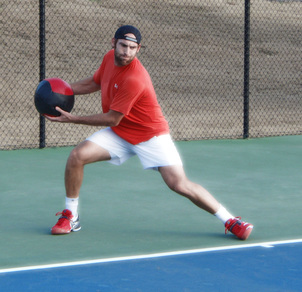What is RPE?
The Rating of Perceived Exertion (RPE) is a very common rating scale used in the scientific literature. It is a simple scale of asking someone how hard or difficult was the exercise or session. It is a good measurement of exercise intensity.
Perceived exertion is how hard you feel like your body is working. It is based on the physical sensations a person experiences during physical activity, including increased heart rate, increased respiration or breathing rate, increased sweating, and muscle fatigue. Although this is a subjective measure, a person's exertion rating may provide a fairly good estimate of the actual heart rate during physical activity (Borg, 1982). Since the 1980s thousands of studies have used this scale to evaluate how difficult the exercise session, training or competition was. Over multiple decades it has held up to scrutiny and is one of the best measures available. Even with all the great technology that is available today, the RPE scale is still the one of the most reliable and accurate ways to measure how intense an athlete feels a workout has been.
From a tennis perspective, the use of the RPE scale is good way to quickly and easily gain a read on how difficult or intense the training session or match was. It has been used by coaches and tennis scientists for decades to monitor athletes to see the perceptions of different types of training programs and to provide insight into when to increase or decrease intensity of workouts. One interesting study has recently been published in Australia highlights that when tennis players and coaches both evaluate the intensity of e a training session, rather good consistency existed when training on hardcourts. However, when playing on claycourts coaches underrate the perception of the training session (Reid et al, 2013). This underrating is in comparison to player rating of the same session.
For The Player:
Monitor your sessional-RPE at the end of each training session and provide yourself a rating of the entire workout on a daily basis. Over the course of a few weeks you will start seeing some trends in the workouts and you can start using this information to adjust the difficulty of the workouts based on your goals.
For The Coach:
Monitor your player’s sessional-RPE daily and have the player monitor his or her sessions daily. Compare the ratings to see how close the player and coach and use this information to effectively adjust training sessions to continue to make weekly improvements.
The Scales
Two scales are commonly used. The original scale was developed by Gunnar Borg and follows a 6-20 range. Whereas, the modified Borg CR-10 scale follows a 0-10 scale..
Traditional Borg Scale (6-20) this information has been adapted from http://www.cdc.gov/physicalactivity/everyone/measuring/exertion.html
The traditional Borg scale was designed to coincide with an athlete’s heart rate. Therefore, 6 represents a resting heart rate value (60) and 20 represents a maximum heart rate value (200). Look at the rating scale below while you are engaging in an activity; it ranges from 6 to 20, where 6 means "no exertion at all" and 20 means "maximal exertion." Choose the number from below that best describes your level of exertion. This will give you a good idea of the intensity level of your activity, and you can use this information to speed up or slow down your movements to reach your desired range.
Try to appraise your feeling of exertion as honestly as possible, without thinking about what the actual physical load is. Your own feeling of effort and exertion is important, not how it compares to other people's. Look at the scales and the expressions and then give a number.
6 No exertion at all
7
Extremely light (7.5)
8
9 Very light
10
11 Light
12
13 Somewhat hard
14
15 Hard (heavy)
16
17 Very hard
18
19 Extremely hard
20 Maximal exertion
9 corresponds to "very light" exercise. For a healthy person, it is like walking slowly at his or her own pace for some minutes
13 on the scale is "somewhat hard" exercise, but it still feels OK to continue.
17 "very hard" is very strenuous. A healthy person can still go on, but he or she really has to push him- or herself. It feels very heavy, and the person is very tired.
19 on the scale is an extremely strenuous exercise level. For most people this is the most strenuous exercise they have ever experienced.
0-10 Scale
0 - Nothing at all
1 - Very light
2 - Fairly light
3 - Moderate
4 - Some what hard
5 - Hard
6
7 - Very hard
8
9
10 - Very, very hard
Resources:
Current Comment from the American College of Sports Medicine on RPE - http://www.acsm.org/docs/current-comments/perceivedexertion.pdf
References:
BORG, G. (1982) Psychophysical bases of perceived exertion. Medicine and Science in Sports and Exercise, 14 (5), p. 377-81
REID, M et al. (2013) Physiological, perceptual, and technical responses to on-court tennis training on hard and clay courts. Journal of Strength and Conditioning Research. 27 (6); 1487-1495





 RSS Feed
RSS Feed
